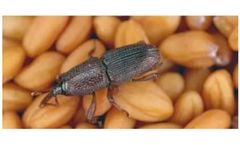Pesticide And Pathogen Contamination Articles & Analysis
10 articles found
The loss of grain in storage relating to or resulting from living things such as insects, pests, rodents, and fungi and form physical rather than biological such as temperature or moisture lead to global losses that exceed 80 million metric tons in grain storage. Most of the time, Aluminium Phosphide is used for fumigation, though it can be dangerous. Also, insects and pests have developed ...
In the process of planting crops, human beings usually suffer from insect pests, which seriously affect the yield and quality of food. In order to prevent and control pests, people have to use pesticides to escort crop planting and production. Organophosphorus is a common pesticide, and improper protection can lead to farmers' organophosphorus poisoning. In order to remove pesticide residues, ...
Shrimp are one of the most popular aquaculture species in the Philippines. Shrimp farming can be highly profitable, with higher harvest rates and relatively low production costs compared to other species when standardized, sustainable aquaculture approaches are followed. Disease outbreaks over the last two decades, however, have led to dramatic declines in the shrimp output and challenges for ...
Periodic assessments of the risk of water contamination by pesticides help decision makers to improve the sustainability of agricultural management practices. In Canada, when evaluating the risk of water contamination by pesticides, there are two main constraints. First, because the area of interest is large, a pesticide transport model with low computational running time is mandatory. Second, ...
In ecotoxicology, appreciation is growing for the influence that ecological interactions have on the toxicity of contaminants, such as insecticides, to sensitive species. Most previous studies, however, have focused on factors that exacerbate insecticide effects on species, while factors that may mitigate these effects have been relatively ignored. In aquatic habitats, a small number of studies ...
Portions of the Santa Maria River and Oso Flaco Creek watersheds in central California, USA, are listed as impaired, under section 303(d) of the Clean Water Act, and require development of total maximum daily load (TMDL) allocations. These listings are for general pesticide contamination, but are largely based on historic monitoring of sediment and fish tissue samples that showed contamination by ...
Received for publication May 5, 2008. A geo-referenced modeling system was developed in this study to investigate the spatiotemporal variability of pesticide distributions and associated ecosystem risks. In the modeling system, pesticide fate and transport processes in soil-canopy system were simulated at field scale by the pesticide root zone model (PRZM). Edge-of-field mass fluxes were ...
Abstract The objective of the study was to determine and compare the current level of exposure of the Ghanaian urban population to hazardous pesticide and fecal coliform contamination through the consumption of fresh vegetables produced in intensive urban and periurban smallholder agriculture with informal wastewater irrigation. A total of 180 vegetable samples (lettuce, cabbage, and spring ...
Regional groundwater vulnerability maps to indicate the impact of leaching of chemicals under different management scenarios were prepared for the Rattaphum Catchment using several leaching models and GIS techniques. The Attenuation Factor (AF) model was used to simulate the leaching potential of several pesticides for selected soils in the catchment under different rates of recharge from ...
Regional groundwater vulnerability maps to indicate the impact of leaching of chemicals under different management scenarios were prepared for the Rattaphum Catchment using several leaching models and GIS techniques. The Attenuation Factor (AF) model was used to simulate the leaching potential of several pesticides for selected soils in the catchment under different rates of recharge from ...






